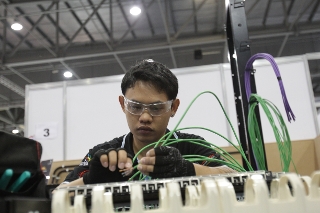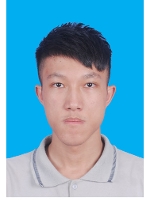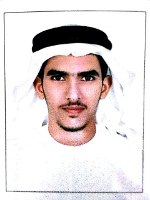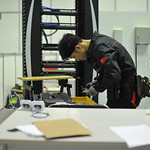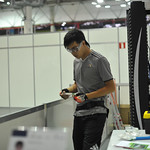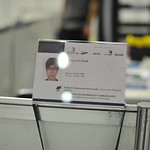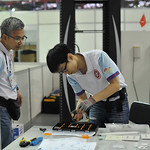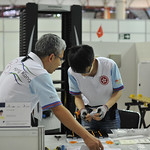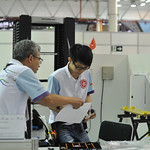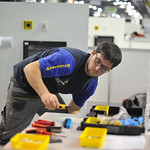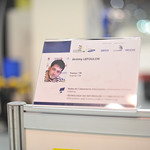Information Network Cabling
Skill Explained
Cable is the medium through which information usually moves from one network device to another. There are several types of cable which are commonly used in network infrastructures. In some cases, a network will utilise only one type of cable, while other networks will use a variety of cable types. The type of cable chosen for a network is related to the network’s topology, protocol and size. Understanding the characteristics of different types of cable and how they relate to other aspects of a network is necessary for the development of a successful network.
The Network Cabling Technician constructs the infrastructure of all the telecommunication networks such as those for Wide Area Networks (WAN), Local Area Networks (LAN) and Cable TV (CATV). This work is highly technical and requires detailed specialised knowledge in order to independently design and install networks that meet clients’ needs and conforms to recognised industry standards. The technician will create the foundation which is the basis for the network, install cables appropriate for the intended use, maintain and test and commission the network.
The technician / installer may work for either a telecommunications or a communications network company. He or she will install network cabling for businesses both large and small or for domestic users, for services such as cable TV, telephone and broadband installations.
Communications networks are crucial to the efficiency of business and commerce. Network failure can result in wasted time and lost revenue. Robust and reliable communications networks are therefore critical to business success.
What the Competitors do at the Competition
The Competitor must have an appropriate level of knowledge and understanding of both the industry and Competition safety standards. The Competitor must also have the knowledge to select the appropriate materials and consumables during the Competition. The Competitor will be judged on:
- Test Project modules simulate the telecommunication network
- Test Project modules which cover installation technologies regarding overall networks such as fibre optic cables and copper cables
- Evaluating the capabilities of troubleshooting
- Introducing Test Projects incorporating wireless technology (such as Wi-Fi)
- Introducing Test Projects constructing high-speed Ethernet such as 10GE and LAN
- Test Projects of Installing or utilising various network applications
The Competitor shall carry out the following tasks:
- Terminate balanced-twisted pair cables in: outlets, patch panel, RJ modular plugs and jacks, etc.
- Terminate a coaxial cable
- Terminate/connect optical fibre
- Install cable distribution racking systems
- Install fibre cables, balanced-twisted pair cables, coaxial cable
- Install FO closures, termination box, TO, patch panels, etc
- Install wireless network
- Install some applications for Ethernet
- Certification test of a copper and of a fibre cable's network
Competitors
Lukas Bucheli
Switzerland
Ho Yin Chung
Hong Kong, China
Jonas Frölander
Sweden
Kevin Glaser
Germany
CARLOS ALEXIS GUEVARA BAUTISTA
Ecuador
Weng Lon Kuok
Macao, China
Seung Yeop Lee
Korea
Jérémy LEFOULON
France
Hongwei Lin
China
Claudia Marcela Liñan Cruz
Colombia
Muhammad Mahmoud Abdullah Ng
Singapore
Abdulrahman Mohamed
United Arab Emirates
Danilo Oliveira
Brazil
Jorge Iván Ortiz Moreno
Mexico
Ryuji Shimase
Japan
Mats Storbråten
Norway
Patrick van de Vreede
Netherlands
DZMITRY YURCHANKA
Belarus
Experts
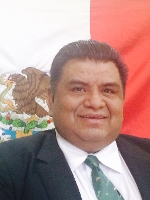
Emmanuel Francisco Alcaraz García
Mexico

Patricio Arellano
Ecuador

Joakim Carlsson
Sweden

Lai Pan Choi
Macao, China

Anton Hrabia
Germany

Dong Man Joo
Korea
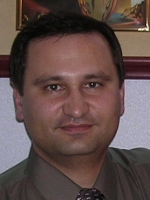
OLEG KHODASEVITCH
Belarus
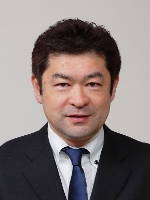
Takuo Kikuchi
Japan

Carlos Harley Leao
Brazil

Ken Koon Hung Lee
Hong Kong, China

Qin Lu
China

Alain Marie
France

Eyad Megdadi
United Arab Emirates

Patric Moser
Switzerland

Pål Nergaard
Norway

Eric Raaymakers
Netherlands
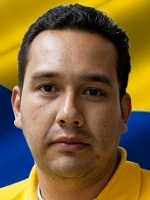
Hugo Sarmiento
Colombia

Edmund Tan
Singapore

